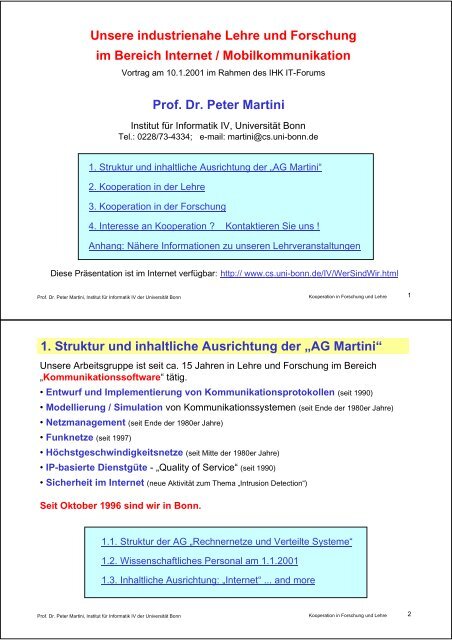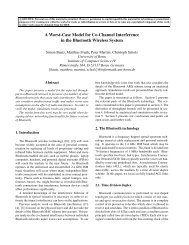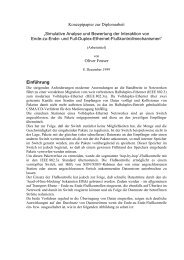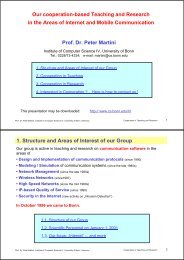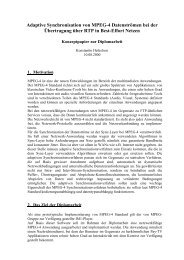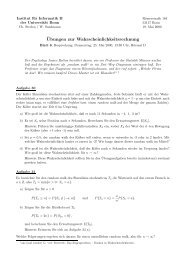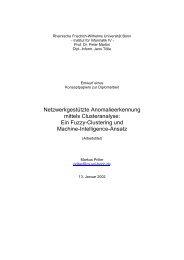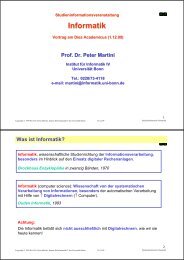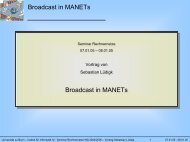Prof. Dr. Peter Martini - Universität Bonn
Prof. Dr. Peter Martini - Universität Bonn
Prof. Dr. Peter Martini - Universität Bonn
Sie wollen auch ein ePaper? Erhöhen Sie die Reichweite Ihrer Titel.
YUMPU macht aus Druck-PDFs automatisch weboptimierte ePaper, die Google liebt.
Unsere industrienahe Lehre und Forschung<br />
im Bereich Internet / Mobilkommunikation<br />
Vortrag am 10.1.2001 im Rahmen des IHK IT-Forums<br />
<strong>Prof</strong>. <strong>Dr</strong>. <strong>Peter</strong> <strong>Martini</strong><br />
Institut für Informatik IV, <strong>Universität</strong> <strong>Bonn</strong><br />
Tel.: 0228/73-4334; e-mail: martini@cs.uni-bonn.de<br />
1. Struktur und inhaltliche Ausrichtung der „AG <strong>Martini</strong>“<br />
2. Kooperation in der Lehre<br />
3. Kooperation in der Forschung<br />
4. Interesse an Kooperation Kontaktieren Sie uns !<br />
Anhang: Nähere Informationen zu unseren Lehrveranstaltungen<br />
Diese Präsentation ist im Internet verfügbar: http:// www.cs.uni-bonn.de/IV/WerSindWir.html<br />
<strong>Prof</strong>. <strong>Dr</strong>. <strong>Peter</strong> <strong>Martini</strong>, Institut für Informatik IV der <strong>Universität</strong> <strong>Bonn</strong> Kooperation in Forschung und Lehre 1<br />
1. Struktur und inhaltliche Ausrichtung der „AG <strong>Martini</strong>“<br />
Unsere Arbeitsgruppe ist seit ca. 15 Jahren in Lehre und Forschung im Bereich<br />
„Kommunikationssoftware“ tätig.<br />
• Entwurf und Implementierung von Kommunikationsprotokollen (seit 1990)<br />
• Modellierung / Simulation von Kommunikationssystemen (seit Ende der 1980er Jahre)<br />
• Netzmanagement (seit Ende der 1980er Jahre)<br />
• Funknetze (seit 1997)<br />
• Höchstgeschwindigkeitsnetze (seit Mitte der 1980er Jahre)<br />
• IP-basierte Dienstgüte - „Quality of Service“ (seit 1990)<br />
• Sicherheit im Internet (neue Aktivität zum Thema „Intrusion Detection“)<br />
Seit Oktober 1996 sind wir in <strong>Bonn</strong>.<br />
1.1. Struktur der AG „Rechnernetze und Verteilte Systeme“<br />
1.2. Wissenschaftliches Personal am 1.1.2001<br />
1.3. Inhaltliche Ausrichtung: „Internet“ ... and more<br />
<strong>Prof</strong>. <strong>Dr</strong>. <strong>Peter</strong> <strong>Martini</strong>, Institut für Informatik IV der <strong>Universität</strong> <strong>Bonn</strong> Kooperation in Forschung und Lehre 2
1.1. Struktur der AG „Rechnernetze und Verteilte Systeme“<br />
Personal:<br />
Grundausstattung (Land NRW):<br />
1 <strong>Prof</strong>essur,<br />
3 wissenschaftliche Bedienstete,<br />
2 technische Bedienstete,<br />
3 studentische Hilfskräfte (15h/W),<br />
Sekretariat.<br />
Sachmittel:<br />
Grundausstattung (Land NRW):<br />
< DM 45.000.- pro Jahr (Tendenz: fallend)<br />
<strong>Dr</strong>ittmittel (Wirtschaft, EU, DFG):<br />
6 wissenschaftliche Angestellte,<br />
mehrere studentische Hilfskräfte.<br />
Stand: 1.1.2001<br />
<strong>Dr</strong>ittmittel:<br />
vertraulich.<br />
Stand: 1.1.2001<br />
Wichtigste Kooperationspartner sind das Nokia Research Center, die Firma<br />
T-Mobil und das Institut für Medienkommunikation (IMK) der GMD.<br />
Ohne die umfassende Unterstützung im Rahmen vertrauensvoller Zusammenarbeit<br />
wären viele unserer Aktivitäten in Lehre und Forschung nicht realisierbar.<br />
<strong>Prof</strong>. <strong>Dr</strong>. <strong>Peter</strong> <strong>Martini</strong>, Institut für Informatik IV der <strong>Universität</strong> <strong>Bonn</strong> Kooperation in Forschung und Lehre 3<br />
1.2. Wissenschaftliches Personal am 1.1.2001<br />
Dipl.-Inform.<br />
Markus Albrecht<br />
(Multimedia)<br />
Dipl.-Inform.<br />
Wolfgang Moll<br />
(Netzmanagement)<br />
Dipl.-Inform.<br />
Jens Tölle<br />
(Sicherheit im Internet)<br />
<strong>Dr</strong>.rer.nat.<br />
Matthias Frank<br />
(Flusskontrolle,<br />
Überlastabwehr<br />
Mobile/drahtlose Kommunikation)<br />
<strong>Prof</strong>. <strong>Dr</strong>.<br />
<strong>Peter</strong> <strong>Martini</strong><br />
Dipl.-Inform.<br />
Simon Baatz<br />
(Bluetooth)<br />
Dipl.-Inform.<br />
Rolf G. Göpffahrth<br />
(QoS und Mobilität<br />
im Internet)<br />
Dipl.-Inform.<br />
Dipl.-Inform.<br />
Wolfgang Hansmann Michael Köster<br />
(Funknetze) (Höchstgeschwindigkeitsnetze)<br />
Dipl.-Inform.<br />
Andre Wenzel<br />
(Simulation)<br />
ca. 40 hochmotivierte Studierende<br />
<strong>Prof</strong>. <strong>Dr</strong>. <strong>Peter</strong> <strong>Martini</strong>, Institut für Informatik IV der <strong>Universität</strong> <strong>Bonn</strong> Kooperation in Forschung und Lehre 4
4<br />
1.3. Inhaltliche Ausrichtung: „Internet ... and more“<br />
Unser Schwerpunkt liegt im Bereich „Techniknahe Kommunikationssoftware“<br />
mit direktem Bezug zu Aktivitäten der Internet Engineering Task Force (IETF).<br />
GSM/GPRS<br />
UMTS<br />
ISDN<br />
ATM-Netz<br />
ATM-<br />
Endgerät<br />
ATM-<br />
Endgerät<br />
Ethernet<br />
Digital Library<br />
GSM/<br />
GPRS<br />
Ethernet<br />
Wireless<br />
LAN<br />
Mobiltelefon<br />
(Sprache,<br />
Daten, ...)<br />
Token<br />
Ring<br />
Ethernet<br />
Ethernet<br />
Bluetooth<br />
Bluetooth<br />
<strong>Prof</strong>. <strong>Dr</strong>. <strong>Peter</strong> <strong>Martini</strong>, Institut für Informatik IV der <strong>Universität</strong> <strong>Bonn</strong> Kooperation in Forschung und Lehre 5<br />
Plenary der IETF im Dezember 2000<br />
atommib MSECADSLMIB<br />
SAAG AVT SNMPV3<br />
Open Security Area Directorate Meeting SNMP Version 3 WG<br />
IMXPBOF<br />
AToMMulticast MIB WGSecurityADSL BOF MIB WG Audio/Video Transport WG<br />
IMXP BOF<br />
IPCDNTLS<br />
WEBDAV<br />
IPS<br />
Transport Layer<br />
IP over Cable Data Network WG<br />
WWW Distributed dhc Authoring v4 MULTI6 ATOMMIB<br />
Security WG NGTRANS<br />
IP Storage BMWG TSVWG DHCIPSEC<br />
and Versioning How WGShould We Multihome In IPv6 BOF Next Generation Transition WG<br />
Dynamic Host Configuration WG AToM MIB WG Benchmarking Methodology Transport WG Area Working Dynamic Group Host Configuration WG<br />
IPTEL<br />
ZEROCONF IPFC<br />
IP Telephony WG<br />
IPNGWG IPO<br />
NNTPEXT<br />
Zero Configuration IPOSPF<br />
over Fibre Channel WGNNTP Extensions WG<br />
SIMPLE AAA IPNG WG IP over Optical WG<br />
NetworkingCALSCH<br />
WG Open Shortest Path First IGP WG CEOT<br />
SIP for Instant<br />
Authentication, Authorization and Accounting WG Calendaring and Scheduling WG Circuit Emulation OverOPES<br />
Transport BOF<br />
Messaging<br />
IPOPTR SIP<br />
IPPM<br />
ISIS TEWG<br />
Open Proxy IPSP Extended<br />
andSPIRITS<br />
Presence<br />
SIGTRAN<br />
Internet Traffic<br />
Session Initiation<br />
IS-IS for IP Internets WG<br />
IP over Packet Transport Rings BOF IP Performance Metrics WG<br />
IP Services Security Architecture Policy WG BOF<br />
Leveraging<br />
Engineering BOF<br />
Service in the PSTN/IN<br />
BEEPProtocol WG<br />
C15N Signaling Transport WG<br />
CDNP<br />
Requesting Extensions InTernet BOF Service WG<br />
Blocks Extensible Exchange Protocol WG Contextualization PIM of Resolution BOF Content Distribution Internetworking BOF<br />
IPSRA<br />
ITRACE<br />
Protocol Independent<br />
NFSV4<br />
SMIME KINK<br />
RSERPOOL<br />
Reliable Server<br />
SYSLOG<br />
Multicast WG<br />
S/MIME<br />
IP Security RemoteDELTAV<br />
Access ICMP Traceback WG<br />
Kerberized Mail Security Internet WG<br />
Network File System Version 4 WG<br />
Negotiation Pooling of Keys BOF WG<br />
Security Issues in DIFFSERV<br />
DOMREG SNMPCONF<br />
Web Versioning and Configuration Management Network Event WG Logging WG Differentiated Services WG DOMain REGistration Configuration Services Management BOF<br />
WEIRD<br />
RMT ISSLL<br />
PRIM<br />
LDAPEXT<br />
SMING SLS L2TPEXTwith SNMP WG<br />
Web Elucidation of<br />
Presence and Instant Messaging Protocol Next Generation BOF Structure Service of Level Specification and Usage BOF<br />
Internet-Related<br />
Integrated Reliable Multicast Services over Specific Link Layers WG<br />
Layer Two Tunneling Protocol Extensions WG<br />
DNSOP<br />
DNSEXT LDAP Extension Management WG Information ENUM WG<br />
FAX<br />
Developments<br />
Domain<br />
Transport WG<br />
Name Server Operations WG RTFM2 DNS Extensions WG Telephone PILC Number Mapping WG Internet Fax WGRAP<br />
MANET<br />
LDAPBIS Performance MBONED SECSH<br />
Implications<br />
MPLS<br />
Resource<br />
Development of the Realtime Traffic<br />
Secure Shell WG<br />
Allocation<br />
Mobile Ad-hoc Networks FORCES<br />
Flow Measurement<br />
WG<br />
LDAP Architecture (v3) Revision SSMBOF<br />
BOFof L ink<br />
FRNETMIB<br />
MBONE Characteristics Deployment WG WG Multiprotocol IDMRLabel Switching WG<br />
Source-Specific Multicast WG<br />
USWG Forwarding and Control Element Separation BOF Frame Relay Service MIB WG Inter-Domain Multicast Routing WG<br />
MSDP<br />
SACRED MMUSIC<br />
TN3270E<br />
KRB-WG<br />
TN3270 Extensions<br />
Multicast Source Discovery LDUP<br />
ROHC<br />
WG<br />
Protocol WG<br />
Securely Available Credentials<br />
Multiparty<br />
WG<br />
Multimedia Session ControlWG<br />
WG<br />
Kerberos WG<br />
LDAP Duplication/Replication/Update GSMP<br />
Protocols WG IDN<br />
Robust IDWG Header Compression WG<br />
General Switch Management<br />
TELSEC<br />
VPIM<br />
WHOIS<br />
Protocol WG SEAMOBY<br />
Internationalized Domain Name WG Intrusion Detection Exchange Format WG<br />
MOBILEIP<br />
User Services<br />
IP Security Protocol WG<br />
Protocol WG<br />
Voice <strong>Prof</strong>ile for<br />
MEGACO PKIX<br />
Telnet Security BOF<br />
Whois Protocol BOF<br />
TRADE<br />
Context and<br />
MIDCOM<br />
Micro-mobility RoutingInternet WG Mail WG<br />
Internet Public-Key Open Infrastructure (X.509) WG<br />
IP Routing for Wireless/Mobile Hosts WG<br />
IMAPEXT<br />
IDR<br />
POLICY<br />
Media Gateway Control WG Middlebox Communication BOF<br />
Trading Protocol<br />
IMPP<br />
Internet Message Access Protocol Extension WG<br />
PPPEXT<br />
Policy Framework WG<br />
WG<br />
WREC<br />
Inter-Domain Routing WGRMONMIB<br />
Point-to-Point Protocol Extensions WG<br />
Instant Messaging and Presence Protocol WG<br />
Web Replication and Caching WG<br />
Remote Network Monitoring WG<br />
<strong>Prof</strong>. <strong>Dr</strong>. <strong>Peter</strong> <strong>Martini</strong>, Institut für Informatik IV der <strong>Universität</strong> <strong>Bonn</strong> Kooperation in Forschung und Lehre 6
2. Kooperation in der Lehre<br />
Ziele unserer Aktivitäten in der Lehre:<br />
• Vermittlung von fundiertem Grundlagenwissen im Bereich „Netztechnik“<br />
(„Berufsfähigkeit“)<br />
• Vermittlung der jeweils neuesten Techniken und Praktiken zu ausgewählten<br />
Bereichen („Berufsfertigkeit“)<br />
•Einsatzvon„Learning-by-Doing“, wo immer dies möglich und sinnvoll ist<br />
• Integration von Studierenden in Industrieprojekte so früh wie möglich<br />
(Studierende werden unter fachlicher Leitung an ihre spätere berufliche Tätigkeit herangeführt)<br />
• Differenzierte Ausbildung mit gezielter Förderung von Leistungseliten<br />
Diese Ziele sind offenbar nur in enger Kooperation mit der gewerblichen Wirtschaft<br />
erreichbar.<br />
2.1. Der Weg zum Erfolg: Lernen, Durchdenken, Anwenden<br />
2.2. Unsere Lehrveranstaltungen im Hauptstudium<br />
2.3. In neun Semestern zum Diplom ...<br />
2.4. Kooperationsmöglichkeiten in der Lehre<br />
<strong>Prof</strong>. <strong>Dr</strong>. <strong>Peter</strong> <strong>Martini</strong>, Institut für Informatik IV der <strong>Universität</strong> <strong>Bonn</strong> Kooperation in Forschung und Lehre 7<br />
2.1. Der Weg zum Erfolg: Lernen, Durchdenken, Anwenden<br />
In unseren Vorlesungen<br />
• vermitteln wir die Grundlagen.<br />
In unseren Übungen und Seminaren<br />
• regen wir an zum selbständigen Durchdenken der<br />
gewonnenen Kenntnisse,<br />
• fördern und leiten wir die Diskussion über Kenntnisse und<br />
aktuelle Fragestellungen.<br />
In unseren Praktika<br />
• geben wir Gelegenheit zum praktischen Einsatz des<br />
gewonnenen Wissens,<br />
• leiten wir die Studierenden zur selbständigen Entwicklung<br />
von Kommunikationssoftware an,<br />
• eignen sich die Studierenden auf der Basis der vermittelten<br />
Berufsfähigkeit die neuesten Techniken und Praktiken an.<br />
<strong>Prof</strong>. <strong>Dr</strong>. <strong>Peter</strong> <strong>Martini</strong>, Institut für Informatik IV der <strong>Universität</strong> <strong>Bonn</strong> Kooperation in Forschung und Lehre 8
2.2. Unsere Lehrveranstaltungen im Hauptstudium<br />
WS<br />
00/01<br />
Seminar<br />
Vorlesung<br />
Rechnernetze I<br />
SS<br />
2001<br />
Seminar<br />
Vorlesung<br />
Mobilkomm.<br />
Vorlesung<br />
Rechnernetze II<br />
“RN” = Rechnernetze<br />
“MK” = Mobilkommunikation<br />
WS<br />
01/02<br />
Seminar<br />
Vorlesung<br />
Rechnernetze I<br />
Praktikum<br />
RN/MK I<br />
SS<br />
2002<br />
Seminar<br />
Vorlesung<br />
Mobilkomm.<br />
Vorlesung<br />
Rechnernetze II<br />
Praktikum<br />
RN/MK II<br />
WS<br />
02/03<br />
Seminar<br />
Vorlesung<br />
Rechnernetze I<br />
Praktikum<br />
RN/MK I<br />
SS<br />
2003<br />
Seminar<br />
Vorlesung<br />
Mobilkomm.<br />
Vorlesung<br />
Rechnernetze II<br />
Praktikum<br />
RN/MK II<br />
Nähere Angaben zu den Inhalten finden sich im Anhang.<br />
<strong>Prof</strong>. <strong>Dr</strong>. <strong>Peter</strong> <strong>Martini</strong>, Institut für Informatik IV der <strong>Universität</strong> <strong>Bonn</strong> Kooperation in Forschung und Lehre 9<br />
2.3. In neun Semestern zum Diplom ...<br />
1. - 4. Sem. Grundstudium<br />
5. Sem.<br />
Orientierung;<br />
Bestimmung der<br />
eigenen Interessen<br />
6. Sem.<br />
Orientierung;<br />
Bestimmung der<br />
eigenen Interessen<br />
7. Sem.<br />
Vertiefung und<br />
Ergänzung<br />
8. Sem.<br />
Vertiefung und<br />
Ergänzung<br />
9. Sem.<br />
Vordiplom<br />
Vorlesung<br />
Rechnernetze I<br />
Einführung, Grundlagen<br />
Vorlesung<br />
Rechnernetze II oder<br />
Mobilkommunikation<br />
Vertiefung, aktuelle Themen<br />
Praktikum<br />
Rechnernetze/<br />
Mobilkommunikation I<br />
Zur Vertiefung, nicht nur für spätere Diplomanden<br />
Praktikum<br />
Rechnernetze/<br />
Mobilkommunikation II<br />
Einstieg in die Diplomarbeit (fließender Übergang)<br />
Diplomarbeit<br />
Weitere Veranstaltungen zur<br />
Einführung in andere Gebiete<br />
der Informatik und zum Nebenfach.<br />
Weitere Veranstaltungen zur<br />
Einführung in andere Gebiete<br />
der Informatik und zum Nebenfach.<br />
Weitere<br />
Veranstaltungen<br />
Weitere<br />
Veranstaltungen<br />
Ausnahmen bestätigen die Regel.<br />
<strong>Prof</strong>. <strong>Dr</strong>. <strong>Peter</strong> <strong>Martini</strong>, Institut für Informatik IV der <strong>Universität</strong> <strong>Bonn</strong> Kooperation in Forschung und Lehre 10
Vergabe von Diplomarbeiten (6 Monate Bearbeitungszeit)<br />
Wir vergeben Diplomarbeiten zu den Themen<br />
• Simulation<br />
von Rechnernetzen,<br />
• Leistungsbewertung von Rechnernetzen,<br />
• Sicherheit<br />
von Rechnernetzen,<br />
• Mobilität<br />
in Rechnernetzen,<br />
• Management<br />
von Rechnernetzen und<br />
• Implementierung von Kommunikationsprotokollen.<br />
Die Mehrzahl der Diplomarbeiten ist eingebettet in die jeweils aktuellen<br />
Forschungsaktivitäten der AG „Rechnernetze und Verteilte Systeme“.<br />
Externe Diplomarbeiten setzen im Regelfall den Abschluss eines Kooperationsvertrags<br />
voraus, in dem insbesondere die Verfügbarkeit der externen<br />
Arbeitsumgebung während der gesamten Bearbeitungszeit geregelt wird.<br />
<strong>Prof</strong>. <strong>Dr</strong>. <strong>Peter</strong> <strong>Martini</strong>, Institut für Informatik IV der <strong>Universität</strong> <strong>Bonn</strong> Kooperation in Forschung und Lehre 11<br />
2.4. Kooperationsmöglichkeiten in der Lehre<br />
•„Berichte aus der Praxis“ im Rahmen von Spezialveranstaltungen<br />
Mitarbeiter Ihres Unternehmens kommen zu uns.<br />
•„Berichte aus der Forschung“<br />
Mitarbeiter unserer Arbeitsgruppe kommen zu Ihnen.<br />
• Bereitstellung von Spezial-Hardware.<br />
Studierende lernen die Hardware kennen, die in Ihrem Unternehmen eingesetzt wird.<br />
• Bereitstellung von Spezial-Software.<br />
Studierende lernen die Software kennen, die in Ihrem Unternehmen eingesetzt wird.<br />
• Gemeinsame Betreuung von Praktikanten<br />
• Gemeinsame Betreuung von Diplomarbeiten<br />
• Mitwirkung unserer Doktoranden in Ihren Projekten<br />
• Gemeinsame Durchführung von Exkursionen<br />
• Gemeinsame Durchführung von Vorlesungen<br />
• Maßgeschneiderte Weiterbildungsangebote<br />
• ...<br />
<strong>Prof</strong>. <strong>Dr</strong>. <strong>Peter</strong> <strong>Martini</strong>, Institut für Informatik IV der <strong>Universität</strong> <strong>Bonn</strong> Kooperation in Forschung und Lehre 12
Beispiel 1: GSM-Ausbildung im WS 99/00<br />
Wintersemester 1999/2000:<br />
• Ein Mitarbeiter des Nokia Research Center (Helsinki) übernimmt 36 Stunden<br />
unserer Vorlesung und vermittelt Lehrinhalte zu GSM, GPRS und UMTS.<br />
• Für die praktische Ausbildung stellt Nokia Hard- und Software bereit.<br />
BSC/A PC<br />
BSC/A<br />
sim<br />
A-if<br />
MSC/A PC<br />
MSC/A<br />
sim<br />
PCM<br />
2Mbit/s<br />
PCM<br />
1 BSS-to-MSC connection per PCM port (max 2)<br />
1 signalling link (MTP) per port (31 time slots)<br />
1 signalling channel (time-slot 16)<br />
1 traffic channel may be connected to handsets (simulating MS-to-PSTN call)<br />
signalling of multiple parallel calls (MOC or MTC)<br />
<strong>Prof</strong>. <strong>Dr</strong>. <strong>Peter</strong> <strong>Martini</strong>, Institut für Informatik IV der <strong>Universität</strong> <strong>Bonn</strong> Kooperation in Forschung und Lehre 13<br />
Beispiel 2: Seminare und Workshops zur Weiterbildung<br />
Mitglieder unserer Arbeitsgruppe wirken an maßgeschneiderter Weiterbildung mit.<br />
Dies gilt aktuell insbesondere für die Bereiche<br />
•„Quality of Service im Internet“,<br />
•„Wireless and Mobile Internet“,<br />
•„Bluetooth“.<br />
<strong>Prof</strong>. <strong>Dr</strong>. <strong>Peter</strong> <strong>Martini</strong>, Institut für Informatik IV der <strong>Universität</strong> <strong>Bonn</strong> Kooperation in Forschung und Lehre 14
3. Kooperation in der Forschung<br />
Unserer Aktivitäten in der Forschung sind eng mit denen in der Lehre verknüpft:<br />
Inhaltlich und finanziell basieren unsere Forschung und Lehre<br />
auf Kooperation mit der gewerblichen Wirtschaft<br />
Finanzielle Basis:<br />
Inhaltliche Basis:<br />
Personalmittel, Sachmittel und „Naturalien“<br />
Ohne den Einsatz der aus <strong>Dr</strong>ittmittelprojekten finanzierten Mitarbeiter wäre unsere<br />
Arbeitsgruppe der hohen Nachfrage seitens der Studierenden nicht gewachsen.<br />
Praxisrelevanz und Zugang zu vertraulicher Information<br />
Im Bereich „Internet“ erfolgen Forschung, Entwicklung und Standardisierung<br />
zeitgleich. In enger Kooperation mit der Wirtschaft haben wir Gelegenheit, rechtzeitig<br />
vertrauliche Dokumente zu erhalten und prägend mitzuwirken.<br />
3.1. „Non-Disclosure Agreements“<br />
3.2. Kernkompetenzen und aktuelle Arbeitsschwerpunkte<br />
3.3. Kooperationsmöglichkeiten in der Forschung<br />
3.4. Ein aktuelles Beispiel: Das EU-Projekt „DRIVE“<br />
3.5. Ein anderes Beispiel: „IP Services over Bluetooth “<br />
<strong>Prof</strong>. <strong>Dr</strong>. <strong>Peter</strong> <strong>Martini</strong>, Institut für Informatik IV der <strong>Universität</strong> <strong>Bonn</strong> Kooperation in Forschung und Lehre 15<br />
3.1. „Non-Disclosure Agreements“<br />
Vertrauensvolle Kooperation setzt häufig die Vertraulichkeit der übermittelten<br />
Information voraus. Dank der freundlichen und engagierten Unterstützung durch die<br />
Rechtsabteilung der <strong>Universität</strong> haben wir bisher noch immer geeignete Wege<br />
gefunden.<br />
Firstofall:<br />
Please sign the<br />
Non-Disclosure<br />
Agreement !<br />
<strong>Prof</strong>. <strong>Dr</strong>. <strong>Peter</strong> <strong>Martini</strong>, Institut für Informatik IV der <strong>Universität</strong> <strong>Bonn</strong> Kooperation in Forschung und Lehre 16
Non-Disclosure (2)<br />
Aufgrund von vonNon-Disclosure Agreements sind sindder<br />
der<br />
Präsentation von vonKooperationsprojekten mit mitder<br />
gewerblichen Wirtschaft enge engeGrenzen gesetzt.<br />
Wir Wirbitten bittenum umVerständnis.<br />
<strong>Prof</strong>. <strong>Dr</strong>. <strong>Peter</strong> <strong>Martini</strong>, Institut für Informatik IV der <strong>Universität</strong> <strong>Bonn</strong> Kooperation in Forschung und Lehre 17<br />
3.2. Kernkompetenzen und aktuelle Arbeitsschwerpunkte<br />
Aktuelle Arbeitsschwerpunkte<br />
Kernkompetenzen<br />
Anforderungsanalysen<br />
Protokoll-Design<br />
Protokoll-Implementierung<br />
Simulation<br />
Messung / Demonstrator<br />
Integrated Services /<br />
Differentiated Services im Internet<br />
Wireless Personal Area Networks /<br />
Bluetooth<br />
Intrusion Detection<br />
Policy-Based Networking<br />
Höchstgeschwindigkeitsnetze<br />
Multi-Radio-Networks<br />
<strong>Prof</strong>. <strong>Dr</strong>. <strong>Peter</strong> <strong>Martini</strong>, Institut für Informatik IV der <strong>Universität</strong> <strong>Bonn</strong> Kooperation in Forschung und Lehre 18
3.3. Kooperationsmöglichkeiten in der Forschung<br />
Aufgrund der engen Verknüpfung von Forschung und Lehre sei hier hingewiesen auf:<br />
2.4. Kooperationsmöglichkeiten in der Lehre<br />
Konkret bieten sich an:<br />
a) Bilaterale Kooperation<br />
Aktuelle Beispiele: Nokia Research Center und T-Mobil<br />
b) Gemeinsame Teilnahme an Projekten mit Landes- oder Bundesförderung<br />
Aktuelles Beispiel: Vorbereitung eines Projektes im Bereich „Wireless Internet“<br />
c) Gemeinsame Teilnahme an EU-Projekten<br />
Aktuelles Beispiel: Das EU-Projekt „Dynamic Radio for IP-Services in Vehicular Environments“<br />
<strong>Prof</strong>. <strong>Dr</strong>. <strong>Peter</strong> <strong>Martini</strong>, Institut für Informatik IV der <strong>Universität</strong> <strong>Bonn</strong> Kooperation in Forschung und Lehre 19<br />
3.4. Ein aktuelles Beispiel: Das EU-Projekt „DRIVE“<br />
Dynamic Radio for IP-Services in Vehicular Environments<br />
http://www.ist-drive.org/<br />
<strong>Prof</strong>. <strong>Dr</strong>. <strong>Peter</strong> <strong>Martini</strong>, Institut für Informatik IV der <strong>Universität</strong> <strong>Bonn</strong> Kooperation in Forschung und Lehre 20
Das Konsortium<br />
Consortium:<br />
UNI Surrey<br />
HHI<br />
<strong>Prof</strong>. <strong>Dr</strong>. <strong>Peter</strong> <strong>Martini</strong>, Institut für Informatik IV der <strong>Universität</strong> <strong>Bonn</strong> Kooperation in Forschung und Lehre 21<br />
... Geld<br />
DRiVE in Figures:<br />
European<br />
Union<br />
5th Framework<br />
Programme<br />
I nformation<br />
S ociety<br />
T echnology<br />
4.6 MEuro<br />
Total: 705 Man months<br />
~30 Engineers per Year<br />
Total: 8.7 MEuro<br />
1.4.2000 Duration of 2 years<br />
31.3.2002<br />
<strong>Prof</strong>. <strong>Dr</strong>. <strong>Peter</strong> <strong>Martini</strong>, Institut für Informatik IV der <strong>Universität</strong> <strong>Bonn</strong> Kooperation in Forschung und Lehre 22
Die Multi-Radio Architektur<br />
Multi-Radio Architecture<br />
ÿþýüû<br />
ÿ ý<br />
Internet<br />
Core Network<br />
Traffic Control<br />
Communication<br />
Platform<br />
û<br />
Server<br />
Unsere Aufgaben liegen im<br />
Bereich der IP-basierten<br />
Mobilitätsunterstützung:<br />
• Einbringung unserer IP-<br />
Kompetenz in den Entwurf<br />
der QoS-Architektur<br />
• Simulation<br />
<strong>Prof</strong>. <strong>Dr</strong>. <strong>Peter</strong> <strong>Martini</strong>, Institut für Informatik IV der <strong>Universität</strong> <strong>Bonn</strong> Kooperation in Forschung und Lehre 23<br />
3.5. Ein anderes Beispiel: „IP Services over Bluetooth“<br />
IP Services over Bluetooth:<br />
Leading the Way to a New Mobility<br />
Markus Schetelig<br />
Nokia Mobile Phones R&D Center, Bochum, Germany<br />
Asko Vilavaara<br />
Nokia Research Center, Helsinki, Finland<br />
Markus Albrecht, Matthias Frank, <strong>Peter</strong> <strong>Martini</strong>, Andre Wenzel<br />
Institute of Computer Science IV, University of <strong>Bonn</strong>, Germany<br />
Titelfolie zum Vortrag auf der 24th Annual IEEE Conference on Local Computer Networks; Boston, MA, Oct. 1999<br />
Das zugehörige Paper wurde mit der „Best Paper Award“ ausgezeichnet.<br />
Der Tagungsband mit dem Originalbeitrag ist bei der IEEE Computer Society Press verfügbar.<br />
<strong>Prof</strong>. <strong>Dr</strong>. <strong>Peter</strong> <strong>Martini</strong>, Institut für Informatik IV der <strong>Universität</strong> <strong>Bonn</strong> Kooperation in Forschung und Lehre 24
Bluetooth in Public Environments<br />
Vision: Ubiquity of Bluetooth enabled devices<br />
”A new dimension in wireless communication. A world where all electronic devices<br />
talk spontaneously. Where connectivity between computers, mobile phones and<br />
portable devices is as simple as switching on the lights.”<br />
Bluetooth Web Site, 1998<br />
+<br />
Low range of Bluetooth:<br />
• Services can be confined to a certain area (e.g. a building)<br />
• Adapt offered services depending on the location of the user<br />
Why don’t we use Bluetooth technology to provide<br />
access to (local) information given there is sufficient need for it<br />
Folie zum Vortrag auf der 24th Annual Conference on Local Computer Networks<br />
<strong>Prof</strong>. <strong>Dr</strong>. <strong>Peter</strong> <strong>Martini</strong>, Institut für Informatik IV der <strong>Universität</strong> <strong>Bonn</strong> Kooperation in Forschung und Lehre 25<br />
Usage Scenarios (1)<br />
In the plane/train:<br />
• Make telephone calls with a Bluetooth<br />
enabled mobile phone or multimedia laptop<br />
• Access local information services:<br />
• Schedule of connecting flights/trains<br />
• Weather information<br />
• City maps<br />
• Information on attractions, sights, museums, cinemas, etc.<br />
• Access the Internet, write and receive email<br />
• Access the company’s intranet<br />
Scenario with low user mobility, as users stay seated<br />
atthesameplacemostofthetime.<br />
Folie zum Vortrag auf der 24th Annual Conference on Local Computer Networks<br />
<strong>Prof</strong>. <strong>Dr</strong>. <strong>Peter</strong> <strong>Martini</strong>, Institut für Informatik IV der <strong>Universität</strong> <strong>Bonn</strong> Kooperation in Forschung und Lehre 26
Usage Scenarios (2)<br />
Railway Station<br />
At the railway station:<br />
• Access local information services:<br />
• Arrivals/Departures of trains<br />
• On which platform does a train arrive/leave<br />
• Location based service: Which train arrives next on the<br />
platform I am on right now<br />
• Play games while waiting<br />
• Access the Internet and Intranet<br />
Scenario with high user mobility,<br />
as users walk around.<br />
Folie zum Vortrag auf der 24th Annual Conference on Local Computer Networks<br />
<strong>Prof</strong>. <strong>Dr</strong>. <strong>Peter</strong> <strong>Martini</strong>, Institut für Informatik IV der <strong>Universität</strong> <strong>Bonn</strong> Kooperation in Forschung und Lehre 27<br />
Usage Scenarios (3)<br />
Location based services:<br />
• Provide digital tours through museums,<br />
zoos, or botanical gardens<br />
• Department store<br />
• Guide customers through the department store<br />
• Attract the attention of the customer to special products<br />
• Track the customers way through the store<br />
The information presented to the user depends<br />
on his/her location.<br />
Folie zum Vortrag auf der 24th Annual Conference on Local Computer Networks<br />
<strong>Prof</strong>. <strong>Dr</strong>. <strong>Peter</strong> <strong>Martini</strong>, Institut für Informatik IV der <strong>Universität</strong> <strong>Bonn</strong> Kooperation in Forschung und Lehre 28
Bluetooth in Public Environments - BLUEPAC<br />
Our solution: BLUEPAC (BLUEtooth Public ACcess)<br />
BLUEPAC<br />
TCP/IP<br />
Bluetooth<br />
Micro-<br />
Mobility<br />
Folie zum Vortrag auf der 24th Annual Conference on Local Computer Networks<br />
<strong>Prof</strong>. <strong>Dr</strong>. <strong>Peter</strong> <strong>Martini</strong>, Institut für Informatik IV der <strong>Universität</strong> <strong>Bonn</strong> Kooperation in Forschung und Lehre 29<br />
Goals of the BLUEPAC Protocol Concepts<br />
• Support of IP over Bluetooth<br />
enabling Bluetooth devices to send and receive IP datagrams<br />
• IP address assignment<br />
assigning local IP addresses in a BLUEPAC area<br />
• Routing facilities<br />
taking care of moving devices that change their corresponding base station<br />
• “Fast” handoff<br />
keeping up connections while devices are moving<br />
• Service Advertisements<br />
locating BLUEPAC services available for different classes of devices<br />
• Optional Support for Mobile IP<br />
offering mobile IP facilities for Bluetooth devices in a BLUEPAC area<br />
Folie zum Vortrag auf der 24th Annual Conference on Local Computer Networks<br />
<strong>Prof</strong>. <strong>Dr</strong>. <strong>Peter</strong> <strong>Martini</strong>, Institut für Informatik IV der <strong>Universität</strong> <strong>Bonn</strong> Kooperation in Forschung und Lehre 30
BLUEPAC Reference Network Architecture<br />
„Public Network“<br />
e.g. Internet<br />
e.g. PSTN<br />
Proxy/<br />
GW<br />
Application<br />
Server<br />
BLUEPAC<br />
Agent<br />
Rest of the world<br />
BLUEPAC Area<br />
Base Station<br />
BLUEPAC Local Area Network<br />
BT<br />
BT<br />
BBS<br />
BT<br />
BT pico cell<br />
Motion between<br />
BT-radio cells<br />
BT<br />
BT<br />
BBS<br />
BT<br />
BT pico cell<br />
BBS<br />
BT<br />
BT<br />
BT<br />
BT pico cell<br />
BT<br />
User with<br />
“foreign”<br />
BT device<br />
Folie zum Vortrag auf der 24th Annual Conference on Local Computer Networks<br />
<strong>Prof</strong>. <strong>Dr</strong>. <strong>Peter</strong> <strong>Martini</strong>, Institut für Informatik IV der <strong>Universität</strong> <strong>Bonn</strong> Kooperation in Forschung und Lehre 31<br />
BLUEPAC Local IP Address Assignment (1)<br />
BLUEPAC Agent<br />
Application Server<br />
Proxy/Gateway<br />
Internet<br />
BLUEPAC<br />
network<br />
reply<br />
Base Station<br />
BT Device<br />
request<br />
Router<br />
Base Station<br />
IP = 10.1.1.42<br />
DNS = 131.220.16.220<br />
Proxy = 131.220.16.221:8080<br />
BT device:<br />
• connects to Base Station<br />
• request/reply to BLUEPAC<br />
agent<br />
• uses given configuration<br />
BLUEPAC agent assigns:<br />
• IP address<br />
• DNS server<br />
• proxy (optional)<br />
• Mail server (optional)<br />
Folie zum Vortrag auf der 24th Annual Conference on Local Computer Networks<br />
<strong>Prof</strong>. <strong>Dr</strong>. <strong>Peter</strong> <strong>Martini</strong>, Institut für Informatik IV der <strong>Universität</strong> <strong>Bonn</strong> Kooperation in Forschung und Lehre 32
BLUEPAC Local IP Address Assignment (2)<br />
BLUEPAC Agent<br />
Proxy/Gateway<br />
Application Server<br />
Internet<br />
BLUEPAC<br />
network<br />
data flow<br />
data flow<br />
Router<br />
BT device is able<br />
to communicate with:<br />
• hosts in the Internet<br />
• local Application Server(s)<br />
• other BLUEPAC devices<br />
(if desired)<br />
Base Station<br />
Base Station<br />
BT Device<br />
IP = 10.1.1.42<br />
DNS = 131.220.16.220<br />
Proxy = 131.220.16.221:8080<br />
Folie zum Vortrag auf der 24th Annual Conference on Local Computer Networks<br />
<strong>Prof</strong>. <strong>Dr</strong>. <strong>Peter</strong> <strong>Martini</strong>, Institut für Informatik IV der <strong>Universität</strong> <strong>Bonn</strong> Kooperation in Forschung und Lehre 33<br />
Handoff Support with Cellular IP<br />
IP addr interface<br />
10.1.1.42 eth0<br />
Proxy/Gateway<br />
Internet<br />
• All packets coming from<br />
BT devices are routed to<br />
the gateway<br />
BLUEPAC<br />
network<br />
Router<br />
IP addr interface<br />
10.1.1.42 eth1<br />
10.1.1.42 eth0<br />
• Packets update the<br />
routing tables on their way<br />
to the gateway<br />
Base Station<br />
Base Station<br />
• Packets can be sent on<br />
multiple interfaces on their<br />
way down<br />
BT Device<br />
• Routes disappear if not<br />
updated regularly<br />
Folie zum Vortrag auf der 24th Annual Conference on Local Computer Networks<br />
<strong>Prof</strong>. <strong>Dr</strong>. <strong>Peter</strong> <strong>Martini</strong>, Institut für Informatik IV der <strong>Universität</strong> <strong>Bonn</strong> Kooperation in Forschung und Lehre 34
BLUEPAC Mobile IP Support (optional)<br />
some other<br />
host<br />
Mobile IP<br />
home agent<br />
HA<br />
home network<br />
Mobile IP<br />
capable<br />
Bluetooth device<br />
BT<br />
BLUEPAC area<br />
gateway<br />
BBS<br />
Internet<br />
GW<br />
BLUEPAC network<br />
BLUEPAC Base<br />
Station<br />
BLUEPAC area network gateway is<br />
• Cellular IP gateway and<br />
• foreign agent<br />
Cellular IP handles routing between<br />
mobile and gateway (i.e. Foreign Agent)<br />
Foreign Agent discovery:<br />
by BBS generated ICMP Router<br />
advertisements<br />
Folie zum Vortrag auf der 24th Annual Conference on Local Computer Networks<br />
<strong>Prof</strong>. <strong>Dr</strong>. <strong>Peter</strong> <strong>Martini</strong>, Institut für Informatik IV der <strong>Universität</strong> <strong>Bonn</strong> Kooperation in Forschung und Lehre 35<br />
Summary: BLUEPAC - IP over Bluetooth (1)<br />
Challenge:<br />
• Bluetooth offers a connection oriented, reliable link layer<br />
• IP does not care about creating Bluetooth connections<br />
Our Solution:<br />
Insert a protocol entity between Bluetooth and IP, which<br />
• discovers Base Stations<br />
• keeps connected to a Base Station<br />
• tries to reconnect on connection failure<br />
Folie zum Vortrag auf der 24th Annual Conference on Local Computer Networks<br />
<strong>Prof</strong>. <strong>Dr</strong>. <strong>Peter</strong> <strong>Martini</strong>, Institut für Informatik IV der <strong>Universität</strong> <strong>Bonn</strong> Kooperation in Forschung und Lehre 36
4. Interesse an Kooperation Kontaktieren Sie uns !<br />
<strong>Prof</strong>. <strong>Dr</strong>. <strong>Peter</strong> <strong>Martini</strong><br />
Tel.: 0228/73-4334<br />
e-mail: martini@cs.uni-bonn.de<br />
<strong>Dr</strong>. Matthias Frank<br />
Tel.: 0228/73-4550<br />
e-mail: matthew@cs.uni-bonn.de<br />
Institut für Informatik IV der <strong>Universität</strong> <strong>Bonn</strong><br />
Römerstr. 164, 53117 <strong>Bonn</strong>; Telefon: 0228/73-4118; Telefax: 0228/73-4571<br />
e-mail: office4@cs.uni-bonn.de http://www.cs.uni-bonn.de/IV<br />
<strong>Prof</strong>. <strong>Dr</strong>. <strong>Peter</strong> <strong>Martini</strong>, Institut für Informatik IV der <strong>Universität</strong> <strong>Bonn</strong> Kooperation in Forschung und Lehre 37<br />
Homepage des Instituts für Informatik IV<br />
www.cs.uni-bonn.de/IV<br />
<strong>Prof</strong>. <strong>Dr</strong>. <strong>Peter</strong> <strong>Martini</strong>, Institut für Informatik IV der <strong>Universität</strong> <strong>Bonn</strong> Kooperation in Forschung und Lehre 38
Anhang: Nähere Informationen zu den Lehrveranstaltungen<br />
„Rechnernetze I“ (Kernvorlesung Hauptstudium)<br />
„Rechnernetze II“ (Spezialvorlesung Hauptstudium)<br />
„Mobilkommunikation“ (Spezialvorlesung Hauptstudium)<br />
Seminare<br />
Praktika<br />
<strong>Prof</strong>. <strong>Dr</strong>. <strong>Peter</strong> <strong>Martini</strong>, Institut für Informatik IV der <strong>Universität</strong> <strong>Bonn</strong> Kooperation in Forschung und Lehre 39<br />
„Rechnernetze I“ (Kernvorlesung Hauptstudium)<br />
4-stündige Vorlesung, 2-stündige Übung in Gruppen, im Wintersemester<br />
Zielgruppen:<br />
•= Studentinnen und Studenten der Informatik im Hauptstudium<br />
•= Studentinnen und Studenten mit Nebenfach Informatik<br />
Inhalte:<br />
•= Protokolle und deren Spezifikation<br />
= (auch Programmieraufgaben)<br />
•= Signaldarstellung und Synchronisation<br />
•= Fehlererkennung und Fehlerkorrektur<br />
•= Rahmen, Zellen und Pakete<br />
•= Namen, Adressen und Routen<br />
•= Flußkontrolle und Überlastabwehr<br />
•= Multimediale Kommunikation<br />
(auch Programmieraufgaben)<br />
<strong>Prof</strong>. <strong>Dr</strong>. <strong>Peter</strong> <strong>Martini</strong>, Institut für Informatik IV der <strong>Universität</strong> <strong>Bonn</strong> Kooperation in Forschung und Lehre 40
„Rechnernetze II“ (Spezialvorlesung Hauptstudium)<br />
4-stündige Vorlesung, 2-stündige Übung in Gruppen, im Sommersemester<br />
Zielgruppe:<br />
•= Studentinnen und Studenten im Hauptstudium mit Vorkenntnissen<br />
aus dem Bereich Rechnernetze (Vorlesung Rechnernetze I)<br />
Inhalte:<br />
• Bewertung der Leistungsfähigkeit von Kommunikationssystemen<br />
• Netzmanagement<br />
• Sicherheit in Netzen<br />
(Programmieraufgaben zu unterschiedlichen Aspekten.)<br />
<strong>Prof</strong>. <strong>Dr</strong>. <strong>Peter</strong> <strong>Martini</strong>, Institut für Informatik IV der <strong>Universität</strong> <strong>Bonn</strong> Kooperation in Forschung und Lehre 41<br />
„Mobilkommunikation“ (Spezialvorlesung Hauptstudium)<br />
4-stündige Vorlesung, 2-stündige Übung in Gruppen, im Sommersemester<br />
Zielgruppe:<br />
•= Studentinnen und Studenten im Hauptstudium mit Vorkenntnissen<br />
aus der Vorlesung Rechnernetze I<br />
Inhalte:<br />
• Mobilfunknetze und ihre Protokolle<br />
• GSM - Global System for Mobile Communication<br />
(Praktische Demonstrationen und Übungen an unserem PC-basierten GSM-Simulator)<br />
• GPRS - General Packet Radio Service - Paketdatendienst in GSM<br />
• WAP - Wireless Application Protocol<br />
• Mobilfunknetze der dritten Generation - UMTS, IMT 2000<br />
(Sprache, Daten, Multimedia ... im Mobilfunknetz)<br />
• Mobilität im Internet<br />
<strong>Prof</strong>. <strong>Dr</strong>. <strong>Peter</strong> <strong>Martini</strong>, Institut für Informatik IV der <strong>Universität</strong> <strong>Bonn</strong> Kooperation in Forschung und Lehre 42
Seminare<br />
Zielgruppe:<br />
• Studentinnen und Studenten mit Interesse an einer Prüfung<br />
im Fach „Praktische Informatik“<br />
Zugangsvoraussetzungen:<br />
• Erfolgreiche Teilnahme an den Übungen zu „Rechnernetze I/II“ bzw. „Mobilkommunikation“<br />
Inhalte:<br />
• Aktuelle Themen aus dem Bereich „Rechnernetze und Verteilte Systeme“<br />
<strong>Prof</strong>. <strong>Dr</strong>. <strong>Peter</strong> <strong>Martini</strong>, Institut für Informatik IV der <strong>Universität</strong> <strong>Bonn</strong> Kooperation in Forschung und Lehre 43<br />
Praktika<br />
Zielgruppe:<br />
• Studentinnen und Studenten mit Interesse an<br />
- einer Vertiefungsprüfung oder<br />
- einer Diplomarbeit<br />
im Gebiet „Rechnernetze und Verteilte Systeme“<br />
Zugangsvoraussetzungen:<br />
• Erfolgreiche Teilnahme an den Übungen zu „Rechnernetze I“ und<br />
„Rechnernetze II“ bzw. „Mobilkommunikation“<br />
• Erfolgreiche Bearbeitung der Einarbeitungsaufgaben<br />
Inhalte:<br />
• Design und Implementierung von Kommunikationsprotokollen<br />
• Mobile und drahtlose Kommunikation<br />
• Multimediale Kommunikation<br />
• Simulation von Kommunikationssystemen<br />
• Netzmanagement<br />
• Sicherheit in Netzen<br />
Bei allen genannten Bereichen: Mitwirkung an aktuellen Forschungsprojekten<br />
<strong>Prof</strong>. <strong>Dr</strong>. <strong>Peter</strong> <strong>Martini</strong>, Institut für Informatik IV der <strong>Universität</strong> <strong>Bonn</strong> Kooperation in Forschung und Lehre 44


